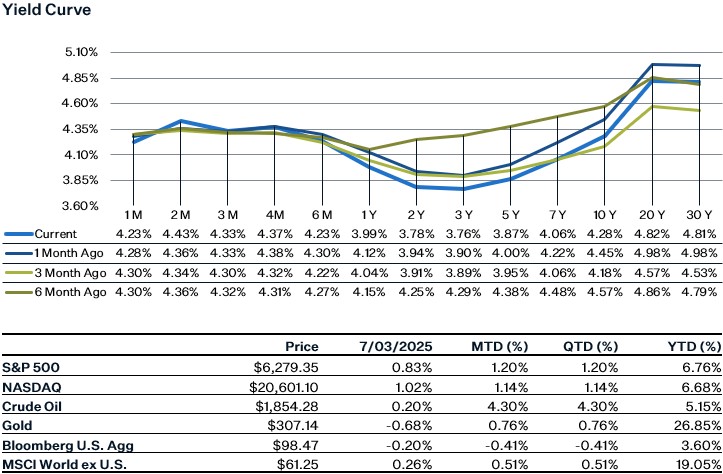
Market Update
Markets ended the week higher last week as optimism grew around potential tariff resolutions and labor market data provided some reassurance to investors that the economy remains in decent shape. On Wednesday last week, President Trump announced a trade deal with Vietnam. Details of the deal include a 20% tariff on Vietnam exports and a 40% tariff on goods that are considered to be trans-shipments (in an effort to crack down on the country being used as a middleman between US and China trade), while Vietnam agreed to drop all levies on U.S. imports. The jobs report headline number came in above estimates on Thursday, although several key metrics in the report showed a continued cooling in the labor market. After the close on Thursday, the House passed the reconciliation bill, which Trump signed into law on Friday. This week attention will shift to the expiration of the temporary tariff suspension. The reciprocal tariff pause is supposed to end on Wednesday, but it looks like that deadline is being extended as Commerce Secretary said on Sunday that tariffs will go into effect on August 1st.
June Jobs Report
Nonfarm payrolls rose 147k in June, above consensus estimates of 118k. However looking at the details of the report, there were several areas of weakness. Private nonfarm payrolls increased 74k which is the weakest number of the year and the lowest since October 2024. Healthcare and social assistance continued to account for most of the job gains, with leisure and hospitality being the only other industry with notable strength. The government sector added 73k jobs, but that was all at the state and local level; federal employment declined by 7k in June.
While the unemployment rate ticked down from 4.2% to 4.1%, this was partly due to the fact that the labor force participation rate declined. Average hourly earnings also came in a little weaker than expected at 0.2% month-over-month which brings the annual wage growth number down 0.2 percentage points to 3.7%. Additionally, the payrolls diffusion index declined to 49.6 which reveals that less than half of private industries increased employment last month. Looking at duration of unemployment, there was a sharp increase in those who are unemployed for 27 weeks or longer. It seems that the market is mainly focusing on the strong headline number in the report and dismissing the weak details, as the odds of September rate cut decreased on Friday (although a cut is still the base case).
ISM Manufacturing Index
The ISM manufacturing index rose slightly to 49.0 in June, although its components showed mixed results, production improved while new orders and employment declined. Notably, prices paid rose to their highest level since July 2022, with respondents citing tariff uncertainty and geopolitical tensions as key challenges. Separately, the S&P Global manufacturing PMI was revised up to 52.9, with gains across output, new orders, and employment. Nominal construction spending fell 0.3% in May, with declines in private construction offsetting a modest rise in public spending.
Sources:
https://markets.jpmorgan.com/jpmm/research.article_page?action=open&doc=GPS-5022080-0
https://www.bls.gov/news.release/pdf/empsit.pdf
https://www.cmegroup.com/markets/interest-rates/cme-fedwatch-tool.html



